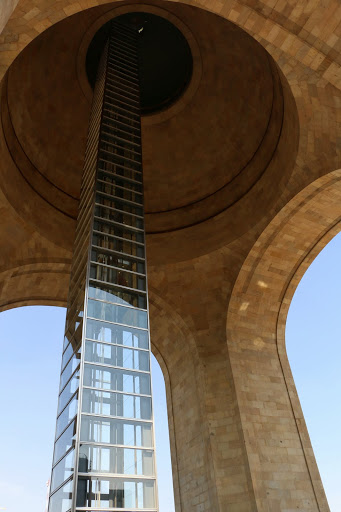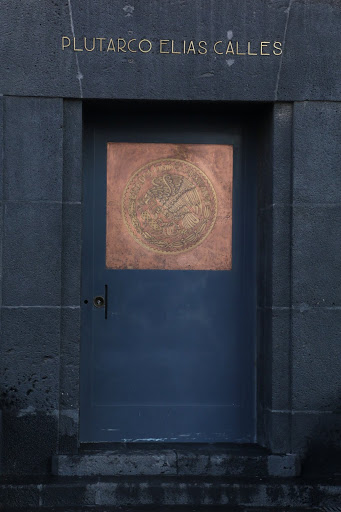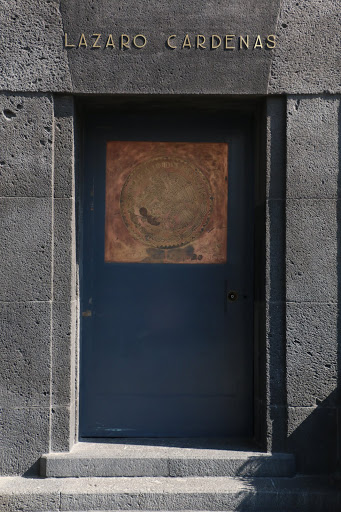We have also written much about the Mexican Mural Movement that grew out of the Mexican Revolution (1910-1917) and whose works are found in a number of buildings in and around Centro. But apart from the sad role played by the Ciudadela in the Revolution, we have not encountered buildings that are direct expressions of that era of upheaval and its aftermath of political and governmental changes. One doesn't build during a civil war or in the post-war effort to establish a functioning government.
Nevertheless, several blocks west of Centro and Bellas Artes, in a staight line following Avenida Juárez, past the Alameda, across Paseo de Reforma, rises one edifice that specifically embodies the Revolution. Curiously, in that very Mexican way of embracing paradoxes, it is the transformed and repurposed shell of President and dictator Porfirio Díaz' grandest project, the Palacio Legislativo Federal.
 |
| Palacio Legislativo Federal as projected by Emile Bénard. Detail of rear (west) facade. Wikipedia |
If it reminds you of another Capitol, that's not surprising. However, begun in 1910, only the dome was completed before the Revolution against Díaz began. After the Revolution, its steel frame remained unfinished and abandoned. Thought was given to tearing down this symbol of a dictator overthrown.
| Photo from website of Monument to the Revolution |
But in the 1930's, President Lázaro Cárdenas, seeking to give a coherent symbolic representation to a Revolution which was, in fact, very fragmented, and a place to enshrine together the remains of its diverse and often opposing heros, decided it should be transformed into the Monument to the Revolution.
Monument to the Revolution
Photo: JRB |
The tallest triumphal arch in the world, it stands 67 metres (220 ft) in height. The Monument was designed by Carlos Obregón Santacilia to go over the existing framework. Its style combines eclectic Art Deco and Mexican socialist realism. Oliverio Martínez designed four massive stone sculptures, one for each corner. This work of Mexican grandeza, grandeur, was completed in 1938.
In 2009, in preparation for the 200th anniversary of the start of the War for Mexican Independence and the 100th anniversary of the start of the Revolution, the Monument was refurbished. A glass-enclosed elevator was added to take visitors to observation decks under the dome.

 |
| The sign at the bottom says, "To the Revolution of yesterday, today and tomorrow." It is a Mexican credo, reflecting the belief that the Revolution was not completed in 1917 or even in the years afterward, but remains to be completed. |
Ideals and Laws Symbolized
The four statues at the top of the four pillars represent Independence, the Laws of Reform (of the era of President Benito Juárez, 1857-1872), and the Agrarian and Workers Laws after the Revolution, seen as two of its major achievements.
 |
| The Country, represented as a woman, guards the Mexican family |
 |
| Laws of Reform (1850's) including disestablishment of the Catholic Church and redistribution of large landholdings. |
 |
| Agrarian Laws providing for redistribution of lands to indigenous peasant farmers. |
 |
| Workers Laws allowing unions and guaranteeing rights of employment, including minimum wage, maximum work hours and social security and health benefits |
Heroes and Enemies Rest Together in Peace
In the bases of the four massive pillars, the remains of Francisco Madero, Venustiano Carranza, Francisco "Pancho" Villa, Plutarco Calles and Lázaro Cárdenas are enshrined in crypts. Emiliano Zapata is buried in Morelos, and Álvaro Obregón is buried in Sonora.


 |
| Villa's crypt is on the back side of one pillar, and has no bronze plaque |


As we tell in more detail in our Pages on the Mexican Revolution: The Short, Tragic Presidency of Francisco Madero and The End of Almost Everyone, Madero was assassinated in 1913 by agents of his general, Victoriano Huerta. Zapata was assassinated in 1919 by agents of Carranza, who was assassinated in 1920 by agents of Obregón, who, in turn, was assassinated in 1928 by a Catholic radical opposed to governmental repression of the Church. Villa was assassinated in 1923, likely by agents of Obregón or Calles. Calles got off with being exiled by Cárdenas in 1936. Cárdenas died of natural causes in 1970.
This laying of some-time allies, turncoats and enemies near each other in death is very much in keeping with Mexican tradition. We recall how the remains of Benito Juárez, president and champion of the liberal Reforms of the mid-19th century and winner of the War of Reform and the French Intervention, lie next to those of both allies and enemies in the Panteón of San Fernando, just a few blocks northeast of this very Monument. In the Mexican perspective, everyone is made equal by Doña Pelona, Lady Death. She eliminates all differences, all contradictions. She resolves all paradoxes.

The statues stand for laws o protect the Country, its Farms, Lands and Workers… good reminder after a week of US Republicans pretending that taking away those laws and regulations will protect everyone not just those who profit.
ReplyDelete